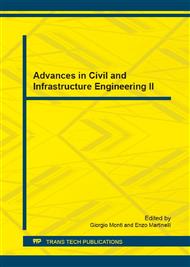[1]
P. Ricci, F. De Luca, G.M. Verderame, L'Aquila earthquake, Italy: reinforced concrete building performance, Bull. Earth. Eng. 9 (2011) 285-305.
DOI: 10.1007/s10518-010-9204-8
Google Scholar
[2]
M. Dolce, D. Cardone, F.C. Ponzo, C. Valente, Shaking table tests on reinforced concrete frames without and with passive control systems, Earthq. Eng. Struct. D. 34 (2005) 1687-1717.
DOI: 10.1002/eqe.501
Google Scholar
[3]
S. Pujol, D. Fick, The test of a full-scale three –story RC structure with masonry infill walls, Eng. Struct. 32 (2010) 3112-3121.
DOI: 10.1016/j.engstruct.2010.05.030
Google Scholar
[4]
A. Stavridis, Analytical and experimental study of seismic performance of reinforced concrete frames infilled with masonry walls, Ph.D. thesis, University of California San Diego (2009).
Google Scholar
[5]
P. Ricci, M.T. De Risi, G. Manfredi, Influence of infill distribution and design typology on seismic performance of low- and mid-rise RC buildings, Bull. Earth. Eng. 5 (2013) 1585-1616.
DOI: 10.1007/s10518-013-9453-4
Google Scholar
[6]
G. Uva, F. Porco, A. Fiore, Approisal of masonry infill walls in the seismic response of RC framed buildings: a case study, Eng. Struct. 34 (2012) 514-526.
DOI: 10.1016/j.engstruct.2011.08.043
Google Scholar
[7]
M. Dolsek, P. Fajfar, Simplified non-linear seismic analysis of infilled reinforced concrete frames, Earthq. Eng. Struct. D. 34 (2005) 49-66.
DOI: 10.1002/eqe.411
Google Scholar
[8]
M. Holmes, Steel frame with brickwork and concrete infilling, ICE Proceeding 19 (1961) 473-478.
Google Scholar
[9]
B. Stafford-Smith, Lateral stiffness of infilled frames, J. Struct. Div. 88 (1962) 183–199.
DOI: 10.1061/jsdeag.0000849
Google Scholar
[10]
R.J. Mainstone, On The stiffness and strengths of infilled frames, Proc. Inst. Civ. Eng. Suppl 4 (1971) 57-90.
Google Scholar
[11]
R.E. Klingner, V.V. Bertero, Earthquake Resistance of Infilled Frames, J. Struct. Div. 104 (1978) 973–989.
DOI: 10.1061/jsdeag.0004947
Google Scholar
[12]
T.B. Panagiotakos, M.N. Fardis, Seismic response of infilled RC frames structures, Proceeding of the 11th World Conference on Earthquake Engineering, Acapulco, Mexico (1996) Paper n. 225.
Google Scholar
[13]
F.J. Crisafulli, A.J. Carr, Proposed macro-model for the analysis of infilled frame structures, Bulletin of the New Zealand Society for Earthquake Engineering 40 (2007) 69–77.
DOI: 10.5459/bnzsee.40.2.69-77
Google Scholar
[14]
A. Fiore, A. Netti, P. Monaco, The influence of masonry infill on the seismic behavior of RC frame buildings, Eng. Struct. 44 (2012) 133-145.
DOI: 10.1016/j.engstruct.2012.05.023
Google Scholar
[15]
H. Crowley, R. Pinho, Simplified equations for estimating the period of vibration of existing buildings, Proceeding of 1st European Conference on Earthquake Engineering and Seismology, Geneva, Switzerland (2006) Paper n. 1122.
Google Scholar
[16]
Regio Decreto Legge n. 229 del 16/11/1939. Norme per la esecuzione delle opere in conglomerato cementizio semplice od armato. G.U. n. 92 del 18/04/1940 (in Italian).
Google Scholar
[17]
CEN Eurocode 8: Design provisions for earthquake resistance of structures – Part 1: General rules. Technical Committee 259/SC8, 2004, Comité Européan de Normalisation, Brussels.
Google Scholar
[18]
CSI, SAP2000 Analysis reference manual, Computer and Structures, Inc. Berkeley, (2006).
Google Scholar
[19]
E. Bal, H. Crowley, R. Pinho, F.G. Gulay, Structural characteristics of Turkish RC building stock in Northern Marmara region for loss assessment applications, ROSE Research Report 2007/03, IUSS Press, Pavia, (2007).
Google Scholar
[20]
A.W. Hendry, Structural masonry, Macmillan education Ltd, London, (1990).
Google Scholar
[21]
N.G. Shrive, Materials and material properties. Reinforced and prestressed masonry, AW Hendry, Longman Scientific and Technical, London, (1991).
Google Scholar
[22]
M. Tomazevic, Shear resistance of masonry walls and Eurocode 6: shear versus tensile strength of masonry, Mater. Struct. 42 (2009) 889-907.
DOI: 10.1617/s11527-008-9430-6
Google Scholar
[23]
NTC 08, Nuove norme tecniche per le costruzioni, D.M. Infrastrutture 14 Gennaio 2008, 2008, Roma.
Google Scholar
[24]
D. Perrone, M. Leone, M.A. Aiello, L'influenza delle tamponature sul periodo elastico di telai esistenti in c. a., Proceeding of C.T.E. conference (2014).
Google Scholar


